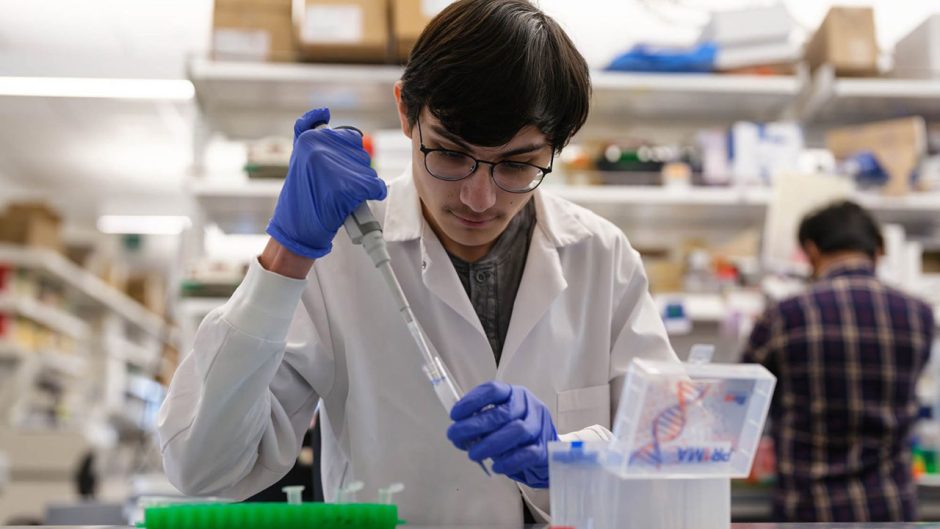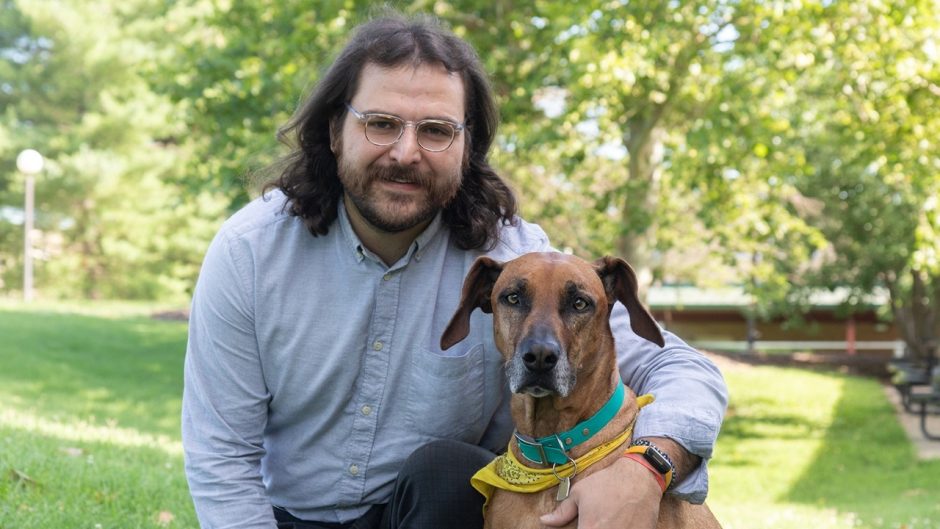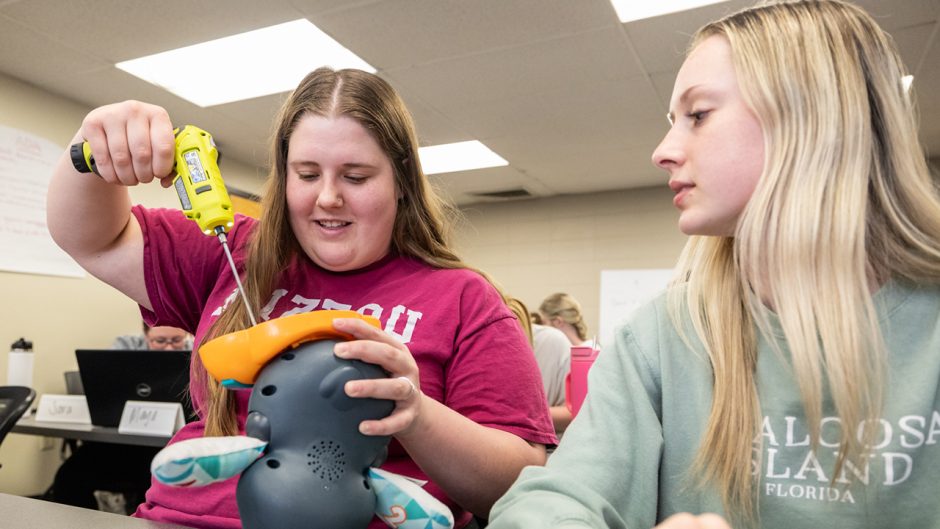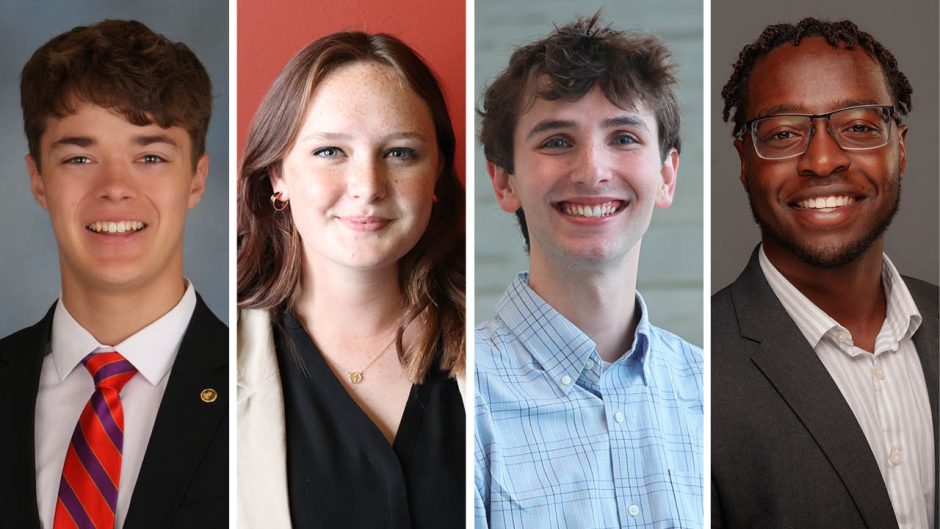Sept. 22, 2017
By Liz McCune
Every day, thousands of students stream by Memorial Union’s iconic tower on the University of Missouri campus. Jacob Fenwick, a freshman from Bonne Terre, Missouri, said he always admired the tower and knew it was connected to veterans but never really stopped to study it until his “Hidden History of Mizzou” Freshman Interest Group — or FIG — took an outing to examine it.

Jared Pettus, left, and Jacob Fenwick pose for a snapshot during Tiger Walk in August. Pettus, of Desloge, and Fenwick, of Bonne Terre, are roommates in Defoe-Graham Hall and belong to the “Hidden History of Mizzou” Freshman Interest Group.
On a recent Wednesday, Soren Larsen, associate professor of geography and faculty leader of the FIG, and Katherine Stevenson, sophomore and peer advisor for the group, began to decode the symbols of the tower, which stands as a memorial to those who lost their lives while serving in the U.S. military during wars and conflicts.
Larsen pointed out the Latin inscription on the clock tower: in sapientia ambulate tempus redimentes, which means “Walk in Wisdom, Redeeming the Time.” Right below the clock face, an owl clutches a bone in its talons.
“The owl can be seen as a symbol of education and wisdom, and the bone represents our mortality,” Larsen said. “One interpretation is that the clock of our lives is literally ticking. These symbols remind us to use our time wisely and that the pursuit of knowledge is among the highest uses of our time.”
Fenwick, an animal sciences major, said his FIG has helped him feel more connected to campus—both by understanding the history behind places like Memorial Union and Speakers Circle—and because he’s had the opportunity to get to know other people who live in his residence hall who share a common interest in geography.
“It’s been great to feel like I immediately have a group I fit in with,” said Fenwick, who grew up watching Tigers athletics and said Mizzou was “always my dream school.”
First launched 22 years ago, Mizzou’s FIGs program has become an integral part of the Mizzou experience for thousands of students and contributes to near-record retention rates.
About a third of MU freshmen living on campus participate in freshman interest groups. FIGs typically consist of 15 to 20 first-year students who are focused on one major, academic interest or common learning theme. The students live on the same floor or an adjacent floor, and each FIG is nested within a larger learning community. In addition to living together, students take two to three general educational classes together based on their FIG theme, and the classes are transferrable to all majors. Finally, participants are required to take a one credit-hour FIG seminar class that aligns with their FIG theme. No additional fees are associated with the program, which is jointly operated by Academic Affairs and Student Affairs.
“At Mizzou, our FIGs program is a national model and offers many benefits to participants,” Provost Garnett Stokes said. “It is one of the true strengths of our university and contributes to the unparalleled excellence in education we offer.”
Over the past two decades, Mizzou’s retention rate has increased to near-record levels and is well above the national average. The retention rate of freshmen who will return as sophomores is even higher for those enrolled in FIGs—about 5 percent higher on average. In addition, surveys and data indicate FIG participants report higher levels of faculty interaction, greater involvement on campus, higher and faster graduation rates and decreased risky behavior such as binge drinking.
“Choosing to live and learn in a FIG is one of the best things students can do to set themselves up for academic success,” said Anna Valiavska, who coordinates MU’s FIGs program. “Not only does the program support students academically, our research also suggests it helps them adjust socially. It gives students an instant social network—people with whom they have something important in common—which is very appealing to incoming freshmen.”
Mizzou piloted the FIGs program in 1995. Since the program’s launch, more than 27,000 students, 1,000 peer advisors and 300 faculty and academic staff members have benefitted from the program.
Although the program began with a focus on freshmen, today Mizzou has learning communities for transfer students and even “boot camps” that place students together for a short duration of time. These campus initiatives introduce students to academic content and undergraduate research opportunities.
This fall, students have had the opportunity to enroll in one of nearly 80 learning groups that are centered around majors, themes or interests such as ROTC leadership, medical careers, and science and mathematics. About one in four undergraduate students participate in the program.
To learn more about the FIGs program, please visit https://reslife.missouri.edu/lc-fig




